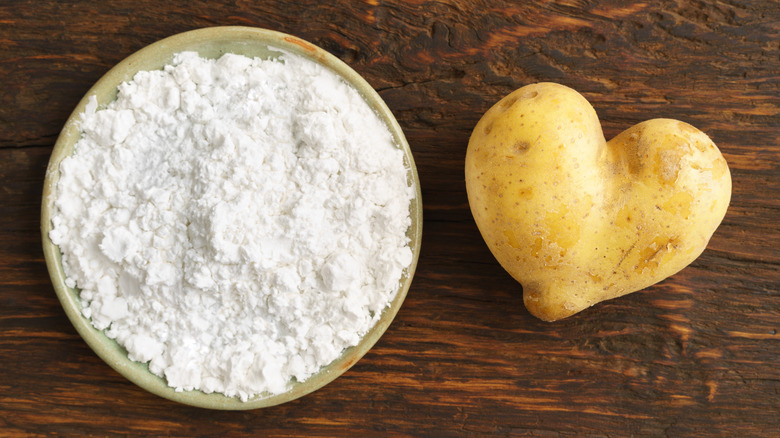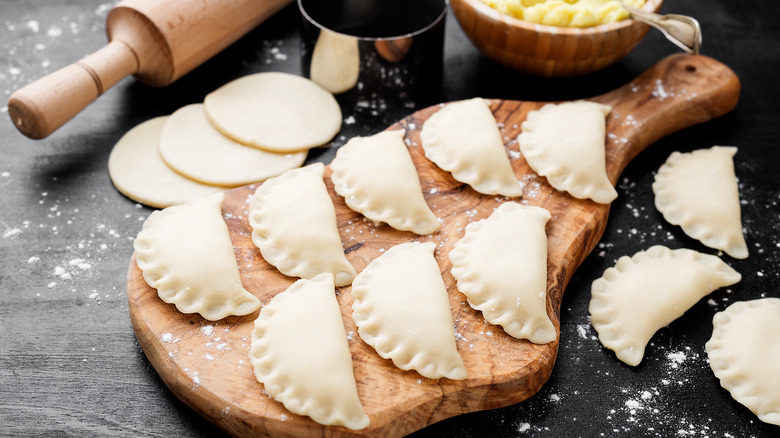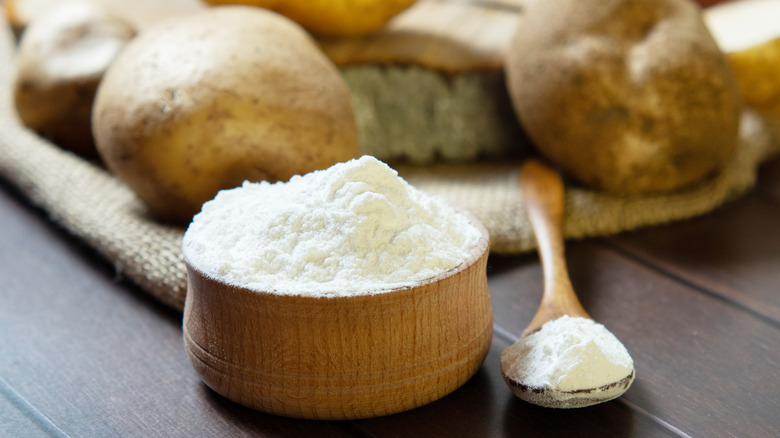When To Use Potato Starch Vs. Potato Flour
The humble potato might be one of the most versatile food ingredients out there. You can boil, bake, or fry it, turn it into flour, or use its starch to bind meatballs and thicken soups. For example, gluten-free bread is often made with potato flour but may also contain potato starch for extra crunch. The latter ingredient acts as a thickener in sauces, gravies, puddings, and stews and can be a great alternative to cornstarch. You can also use it in baked goods, but not as a substitute for potato flour.
Feeling confused? You're not alone. Many people assume that potato flour and potato starch do pretty much the same thing, but these powdered ingredients couldn't be more different. The flour is made from dehydrated potatoes and can be used in baked goods, pasta, noodles, and gluten-free snacks. Like other types of flour, it's rich in protein, vitamins, and minerals. The starch is extracted from raw potatoes and then dried into a powder. It's rich in carbohydrates, particularly amylose and amylopectin, but it contains no other nutrients.
Each of these products has a distinct composition and different uses. While both are suitable for gluten-free cooking, you cannot replace potato flour with potato starch, or the other way around.
Use potato flour in baked goods or as a thickener
Potato flour can replace wheat flour in most recipes, and you can also use it as a thickening agent in soups, sauces, and stews. If a recipe calls for wheat flour, replace 15% to 25% of it with potato flour, depending on what you're cooking. For example, yeast bread is often made with 85% wheat flour and 15% potato flour. If you're on a gluten-free diet, you can use a mix of potato flour and rice, oat, almond, coconut, or quinoa flour in baked goods.
This ingredient absorbs moisture and, therefore, should be combined with other types of flour. If, say, you want to make chocolate chip cookies, consider using potato and coconut flour instead of all-purpose flour. To get a crispy outer layer, coat meat, poultry, or vegetables in potato flour before frying or baking them. You can also use it in gluten-free pancakes or waffles, or as a binding agent in meatloaf, burgers, and sausages.
Some people substitute potato starch for potato flour in bread recipes, but that's not ideal. If you go this route, the bread will be less nutritious and flavorful than its conventional counterpart. A better option is to replace potato flour with rice flour, potato flakes, mashed potatoes, or arrowroot powder, depending on the recipe.
Potato starch works best as a substitute for cornstarch
Although you can use potato flour as a binding and thickening agent, potato starch should be your go-to choice. First of all, it gives sauces, soups, and gravies a smooth texture without changing their color or flavor. Second, it consists primarily of amylose and amylopectin and, therefore, is a better binding agent than potato flour (which is only 83% starch). Moreover, it can extend the shelf-life of yeast bread, pies, pastries, and other baked goods while improving their texture.
But that's not all. As it turns out, potato starch is the secret to getting the crunchiest batter-fried chicken due to its ability to absorb moisture. Plus, it can withstand high temperatures and make the meat tender. All you need to do is mix it with salt and pepper, and then coat the chicken with it before frying. Add paprika, sesame seeds, red pepper flakes, or garlic powder for extra flavor.
As a general rule, use potato starch as a substitute for cornstarch in a 1:1 ratio. Add it to stir-fries, cookies, sourdough bread, cakes, cream soups, and other dishes, or use it in traditional recipes, such as bubur sagu (Indonesian porridge) and helmipuuro (Finnish porridge). You can also mix it into fruit pie fillings to make them thicker and smoother and improve freeze-thaw stability.


